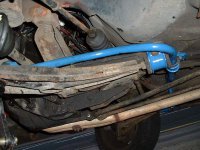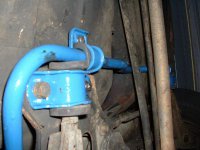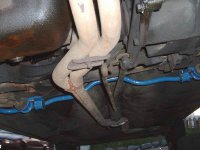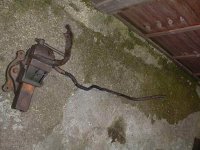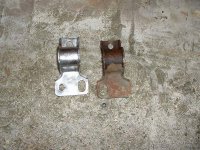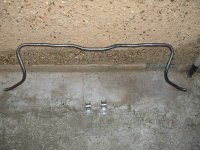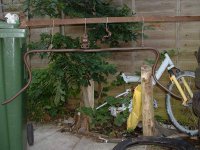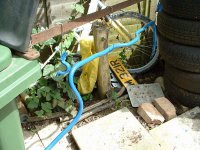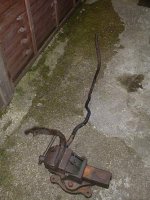At last, I finally managed to fit the turbo anti-roll bar to my little 45S. I bought the roll bar and the brackets way back in May from a guy stripping a dead turbo. What I didn't realise was that I needed the suspension arm brackets AS WELL AS the roll bar brackets. :bang:
Luckily Fro$ty pointed me to the MSN turbocollective group, where I managed to find some from another turbo being broken down in London.
Anyway, as the original bits were all rather rusty I decided to clean them up and paint them. One to make them look good and two, to stop them from rusting again. They were painted blue as I had a tin of blue Smoothrite lying around that I hadn't used for anything. Seemed a shame to waste it!
However, it was a bit futile as I ended up scratching a lot of it when fitting the parts due to lack of clearance
The first series of pictures show the parts being cleaned to bare metal using a drill and wire brush, then being painted in anti-rust primer. Plus you can see the roll bar in it's rather bright blue new paintwork!
Luckily Fro$ty pointed me to the MSN turbocollective group, where I managed to find some from another turbo being broken down in London.
Anyway, as the original bits were all rather rusty I decided to clean them up and paint them. One to make them look good and two, to stop them from rusting again. They were painted blue as I had a tin of blue Smoothrite lying around that I hadn't used for anything. Seemed a shame to waste it!
However, it was a bit futile as I ended up scratching a lot of it when fitting the parts due to lack of clearance
The first series of pictures show the parts being cleaned to bare metal using a drill and wire brush, then being painted in anti-rust primer. Plus you can see the roll bar in it's rather bright blue new paintwork!
'L' shaped brackets
The next set of pictures shows the two 'L' shaped brackets that are needed to fit the anti-roll bar to non turbo models. These locate one end of the front suspension arms as well as the anti-roll bar itself.
These were cleaned up and painted like the other bits, bright blue again
Oh, and the red brackets you can see in one pictures are the hatchback brackets. Thought I might as well paint those also in my bid to prevent my Uno from going rusty!
So now I had lots of nice shiny brackets and roll bar to fit.
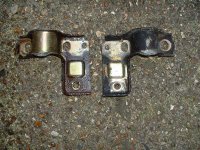
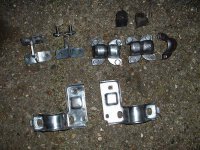
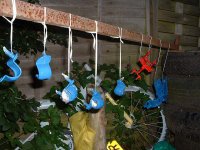
Fitting
And now I had all the bits ready for fitting. All laid out neatly, with some stainless steel bolts and nuts. But bear in mind I used the original steel bolts for the main suspension arm bolts as stainless steel should NOT be used for load bearing parts. This is because stainless is more fragile than mild steel and has a habit of fracturing.
As the anti-roll bar is not under the same kind of pressure as a suspension arm, I used stainless fasteners that won't go rusty.
Fitting was to be honest, a pain! I though it would be easy after pulling off a roll bar from one of the scrapped turbos, but then again I forgot that it didn't have an exhaust or gearbox fitted...
So I had to disconnect the gearchange linkages at the gearbox to drop them down and give enough clearance for the roll bar to pass over them and the exhaust. Of course, in the process of doing so I managed to scratch my nice blue paintwork
I fitted the inner brackets first, which might have been the wrong way of doing it. One of the 10mm nuts that holds on the suspension arm brackets came off nice and easily, but that was probably because I changed the arm to replace it a couple of years ago. The other just spun round and refused to budge. They aren't really load bearing, but you can't get the suspension arm bracket off without removing them first. After cussing and cursing and throwing spanners around all I succeeded in doing was snapping the bolt with nut clean off. I hope it's true that they aren't needed...
So now I had to fit the turbo suspension brackets into place, then bolt up the anti-roll bar brackets and bushes. Trying to push the brackets into place against the rubber bushes didn't give enough clearance to fit the bolts. I had to scratch my new paint by using a trolley jack to push the brackets up enough to fit the bolts.
Once I'd done the two inner brackets I had to fit the two outer brackets that fit onto the suspension arms. These were also a pain, as the suspension arm has to be raised with a trolley jack, then the roll bar end has to be pushed down so that the brackets locate into the two holes in the suspension arm. Really a two man job, but with lots of swearing I managed to do it on my own.
Also, it helps to fit the outer brackets to the roll bar BEFORE fitting the roll bar to the car! They can be fitted in situ, but it is f**king difficult!
Once everything was bolted up, the car was lowered back onto the ground. Now I had to crawl underneath again and tighten the bolts with a torque wrench to the correct settings. The manual states that four people need to be in the car or something like that before the bolts are tightened, but as I didn't have four people to hand and I rarely carry four people I had to ignore this instruction...
So after all this grief, how does it affect the suspension of my 45S?
Well, I took it for a test drive, and by the time I came back I wondered why Fiat didn't fit ALL Unos with a front anti-roll bar. What it doesn't do is make the ride hard, in fact it hardly changes at all. What it does do is make the car sit much, much more flat when cornering.
Originally my Uno rolled all over the place with enthusiastic cornering, but now it hardly seemed to roll at all! I seemed to have the best of both worlds, compliant suspension AND flat handling.
What it has shown up is the original skinny 135 tyres. Now it corners so much flatter I push it harder, and the 135's are struggling to cope. Time to refurbish those X1/9 alloys with 165 section tyres fitted
If anyone is wanting to improve the handling of their non Turbo Uno, then I strongly recommend fitting a turbo anti-roll bar. It makes a big difference, and probably is more effective than fitting harder springs. You get to keep the original ride comfort, and make the cornering much flatter. Mine hardly seems to roll at all now.
One last thing, you'll probably have to get a lot of the brackets off a stripped turbo, as according to my local Fiat dealer they are no longer available new...
To sum up, I heartily recommend fitting an anti roll bar to any non turbo Uno!
